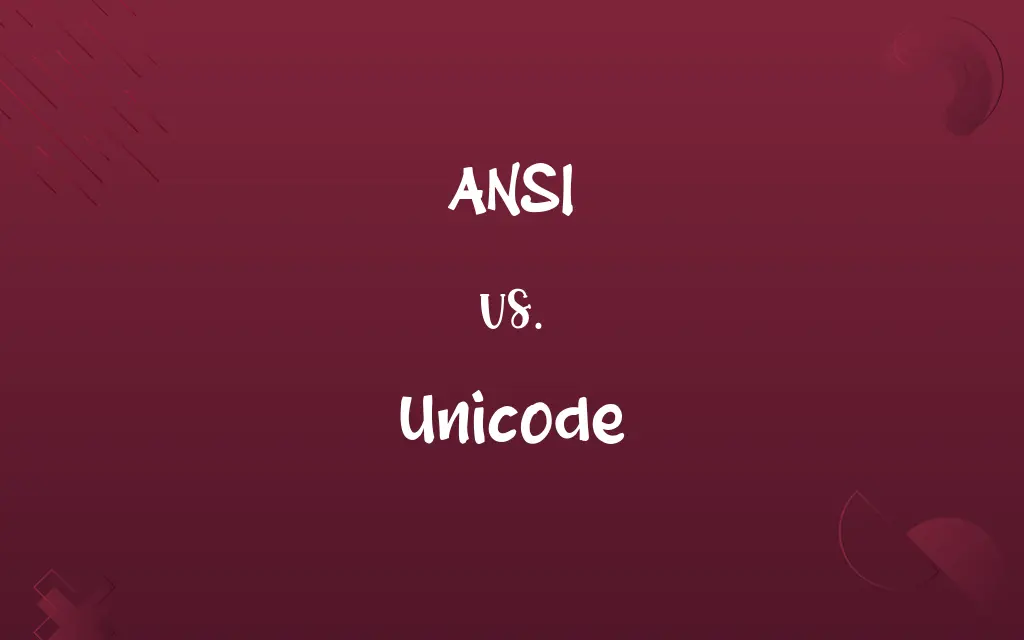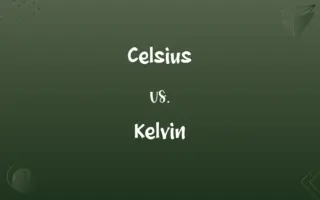ANSI vs. Unicode: Know the Difference

By Shumaila Saeed || Published on January 1, 2024
ANSI is a character encoding standard mainly used for representing English, while Unicode is a universal character set supporting multiple languages and scripts.

Key Differences
ANSI (American National Standards Institute) encoding is a collection of character sets like Windows-1252, used primarily for English and Western European languages. In contrast, Unicode is a comprehensive character set that includes characters, symbols, and emojis from various languages and scripts around the world.
Shumaila Saeed
Jan 01, 2024
While ANSI encodings are limited in scope and can represent a maximum of 256 characters, Unicode has a much larger capacity, being able to encode over a million characters. This makes Unicode suitable for a global audience.
Shumaila Saeed
Jan 01, 2024
Unicode supports complex text rendering required for languages like Arabic and Devanagari, which ANSI cannot handle. Conversely, ANSI’s simplicity makes it suitable for applications where only English or Western European languages are used.
Shumaila Saeed
Jan 01, 2024
ANSI encoding is more compatible with older software and systems, whereas Unicode is widely adopted in modern computing for its versatility and comprehensive coverage of characters and symbols.
Shumaila Saeed
Jan 01, 2024
The transition from ANSI to Unicode has been significant in technology, allowing for better cross-language and cross-platform communication. Unicode's ability to represent characters from virtually all writing systems makes it indispensable in today's interconnected world.
Shumaila Saeed
Jan 01, 2024
ADVERTISEMENT
Comparison Chart
Character Support
Limited to 256 characters, mainly Western.
Over 1 million characters, globally inclusive.
Shumaila Saeed
Jan 01, 2024
Language Coverage
English and some European languages.
Supports most languages and scripts.
Shumaila Saeed
Jan 01, 2024
Capacity
Single-byte (up to 256 characters).
Multi-byte (up to 1,114,112 points).
Shumaila Saeed
Jan 01, 2024
Usage
Older systems, specific to certain languages.
Modern computing, universal application.
Shumaila Saeed
Jan 01, 2024
Complex Script
Inadequate for complex text rendering.
Supports complex and right-to-left scripts.
Shumaila Saeed
Jan 01, 2024
ADVERTISEMENT
Standardization
Various ANSI standards for different regions.
Single standard for worldwide use.
Shumaila Saeed
Jan 01, 2024
Compatibility
Better with legacy systems.
Required for modern, international applications.
Shumaila Saeed
Jan 01, 2024
File Size
Generally smaller for Western languages.
Larger due to wider character set.
Shumaila Saeed
Jan 01, 2024
Globalization
Limited use in global context.
Essential for global digital communication.
Shumaila Saeed
Jan 01, 2024
ANSI and Unicode Definitions
ANSI
An encoding system not suitable for non-Western characters.
To include Japanese characters, ANSI is not adequate.
Shumaila Saeed
Dec 25, 2023
ADVERTISEMENT
Unicode
A universal character encoding standard.
Unicode supports almost all scripts used worldwide.
Shumaila Saeed
Dec 25, 2023
ANSI
A character encoding used mainly for English.
Older documents are often in ANSI encoding.
Shumaila Saeed
Dec 25, 2023
Unicode
An encoding capable of representing over a million characters.
Ancient scripts are also included in Unicode.
Shumaila Saeed
Dec 25, 2023
ANSI
A set of standards for encoding characters in the computer industry.
The text file is encoded in ANSI format.
Shumaila Saeed
Dec 25, 2023
Unicode
A standard that allows computers to consistently represent text.
Unicode is essential for multilingual websites.
Shumaila Saeed
Dec 25, 2023
ANSI
A collection of code pages used for different languages.
ANSI has different versions for various European languages.
Shumaila Saeed
Dec 25, 2023
Unicode
An encoding system that includes a wide range of characters and symbols.
Emojis are a popular part of Unicode.
Shumaila Saeed
Dec 25, 2023
ANSI
A standard adopted by American National Standards Institute.
ANSI standards were prevalent in early computing.
Shumaila Saeed
Dec 25, 2023
Unicode
A solution to the limitations of traditional character encodings.
Unicode has revolutionized digital communication.
Shumaila Saeed
Dec 25, 2023
Unicode
A character encoding standard for computer storage and transmission of the letters, characters, and symbols of most languages and writing systems.
Shumaila Saeed
Dec 13, 2023
Repeatedly Asked Queries
Is Unicode compatible with all modern systems?
Yes, it's widely compatible.
Shumaila Saeed
Jan 01, 2024
What encoding schemes are commonly used with Unicode?
UTF-8, UTF-16, and UTF-32 are commonly used encoding schemes for Unicode.
Shumaila Saeed
Jan 01, 2024
Can ANSI encode Chinese characters?
No, ANSI is inadequate for Chinese characters.
Shumaila Saeed
Jan 01, 2024
How does Unicode handle emoji and special symbols?
Unicode includes a wide range of emoji and special symbols in its character repertoire.
Shumaila Saeed
Jan 01, 2024
Does ANSI have a single standard?
No, it has various versions for different languages.
Shumaila Saeed
Jan 01, 2024
What is UTF-8?
UTF-8 is a variable-length encoding for Unicode that uses one to four bytes per character.
Shumaila Saeed
Jan 01, 2024
What is UTF-16?
UTF-16 is a fixed-length encoding for Unicode that uses two or four bytes per character.
Shumaila Saeed
Jan 01, 2024
Is Unicode backward compatible with ASCII?
Yes, the first 128 characters in Unicode (U+0000 to U+007F) are identical to ASCII characters.
Shumaila Saeed
Jan 01, 2024
Can Unicode represent all the world's characters?
Yes, Unicode is designed to encompass characters from all known writing systems.
Shumaila Saeed
Jan 01, 2024
What is the advantage of using Unicode in software development?
Unicode enables software to handle multilingual text and ensures global compatibility.
Shumaila Saeed
Jan 01, 2024
What is UTF-32?
UTF-32 is a fixed-length encoding for Unicode that uses four bytes per character.
Shumaila Saeed
Jan 01, 2024
Can I display Unicode characters on any device or platform?
Unicode support depends on the device and software, but it is widely supported in modern systems.
Shumaila Saeed
Jan 01, 2024
Are there different versions of Unicode?
Yes, Unicode standards are periodically updated to include new characters and features. Unicode versions are identified by a year, such as Unicode 14.0.
Shumaila Saeed
Jan 01, 2024
Is Unicode the same as UTF-8?
No, Unicode is a character encoding standard, while UTF-8 is one of the encoding schemes used to represent Unicode characters.
Shumaila Saeed
Jan 01, 2024
Is there a specific Unicode consortium that maintains Unicode standards?
Yes, the Unicode Consortium is responsible for maintaining and developing Unicode standards.
Shumaila Saeed
Jan 01, 2024
Share this page
Link for your blog / website
HTML
Link to share via messenger
About Author
Written by
Shumaila SaeedShumaila Saeed, an expert content creator with 6 years of experience, specializes in distilling complex topics into easily digestible comparisons, shining a light on the nuances that both inform and educate readers with clarity and accuracy.








































































